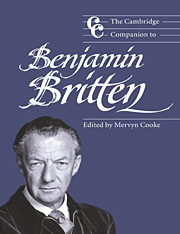Book contents
- Frontmatter
- Introduction
- Part one Apprenticeship
- Part three Perspectives
- 9 Distant horizons: from Pagodaland to the Church Parables
- 10 Violent climates
- 11 Britten as symphonist
- 12 The concertos and early orchestral scores: aspects of style and aesthetic
- 13 The chamber music
- 14 Music for voices
- Part four The composer in the community
- Notes
- Index of Britten's works
- General index
12 - The concertos and early orchestral scores: aspects of style and aesthetic
from Part three - Perspectives
Published online by Cambridge University Press: 28 September 2011
- Frontmatter
- Introduction
- Part one Apprenticeship
- Part three Perspectives
- 9 Distant horizons: from Pagodaland to the Church Parables
- 10 Violent climates
- 11 Britten as symphonist
- 12 The concertos and early orchestral scores: aspects of style and aesthetic
- 13 The chamber music
- 14 Music for voices
- Part four The composer in the community
- Notes
- Index of Britten's works
- General index
Summary
It is tempting to speculate on the kind of composer Britten might have become if he had gone on to write that second piano concerto, composed a successor to his ‘rather serious’ Violin Concerto, or followed along the path of symphonic, purely instrumental composition opened up in 1940 by his Sinfonia da Requiem. In the event, the student of Britten's music has to be satisfied with the Cello Symphony of 1963 as a long-postponed return to the preserve of ‘absolute’ music – a preserve from which Britten may seem to have become creatively estranged since his well-nigh total commitment to opera and song-cycle after Peter Grimes in 1945. Yet this divorce from ‘abstract’ sonata form, from the socalled ‘sonata cycle’ and its three or more movement musical ‘plot’ was by no means confrontationally hostile and – to say the least – a covert relationship continued. In 1945 (at the instigation of Curzon) he revisited his Piano Concerto – by now seven years old – and replaced the original third movement (‘Recitative and Aria’) with a fine reflective passacaglia that managed to integrate thematically and stylistically with the other three movements. Moreover, the achievement of the Second and Third String Quartets as well as the concentrated Sonata for cello and piano of 1961 testify to a significantly recurring need for the committed opera composer (who at times found himself not beyond critical reproof for the apparent over-reliance of his music upon words) to test himself in the arena of the ‘absolute’ – albeit through the ‘private’ world of chamber music.
- Type
- Chapter
- Information
- The Cambridge Companion to Benjamin Britten , pp. 233 - 244Publisher: Cambridge University PressPrint publication year: 1999



